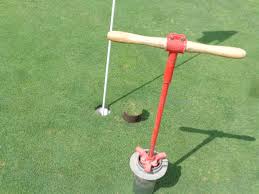Earlier this month at the CGA Mid-Amateur Championship, an unusual situation happened on the putting green on the 8th hole during the second round. A player replaced the flagstick back into the hole and as he walked away his towel wrapped itself around the flagstick and pulled it with him as he walked away, which caused the cup to push against the earth below the surface of the putting green. As the flagstick moved the cup, it displaced the earth around the hole and cause the earth to actually rise up (like a molehill). It also changed the shape of the hole from a 4 ¼ inch circle to an egg-like oval.
The player, who had finished the hole, was unsure of what to do and proceeded to call a member of the Committee to the putting green to investigate how to properly proceed. In the meantime, the group behind him was unaware of the situation and continued play of the hole and hit their approach shots to within 15 feet of the hole. Once the players reached the putting green, they saw how badly the hole was damaged and decided to wait until the hole was fixed to finish putting.
Under Rule 16, a player may fix damage done to the hole itself if it is clearly damage from a ball mark. Otherwise, for the hole to be fixed, the player must first try and reach a member of the Committee to fix the hole. If a member of the Committee is not readily available, then the player may try and fix the hole back to its proper dimension without penalty.
The diminsions of this hole, as well as the new molehill just in front of the hole, are now wholly different than what is required under the Rules. A member of the Committee was now on the putting green along with the superintendent to try and see how much the hole could be repaired. It was determined that the hole and the molehill were bad enough that the hole needed to be relocated.
Relocating a hole is not an ideal situation, but sometimes it is necessary to finish the proper playing of a round. In this case, Decision 33-2b/2 gives us the correct way to proceed if a new hole needs to be cut mid-round. The new hole was now cut exactly 3 feet to the right of where the damaged hole had been. This new hole location was close enough it would still yield the same type of putt (slope, speed, distance, etc.) as the damaged hole location had. We needed to be sure that there would be no advantage to playing the new hole location vs. the old hole location, and vice versa.
As mentioned earlier, there are still two golf balls on the green that were at approximately 15 feet from the old hole location. Their shots into the old hole location had given them their putts and they had rightfully earned that spot on the golf course. So, in equity, the Committee required the players to move their ball to a location that was as close as possible to the type of putt they had been given by their shot into the original hole location.
The third player was just off the green and since his ball lay through the green, he was not entitled to move his ball, and must play out to the new hole location.


